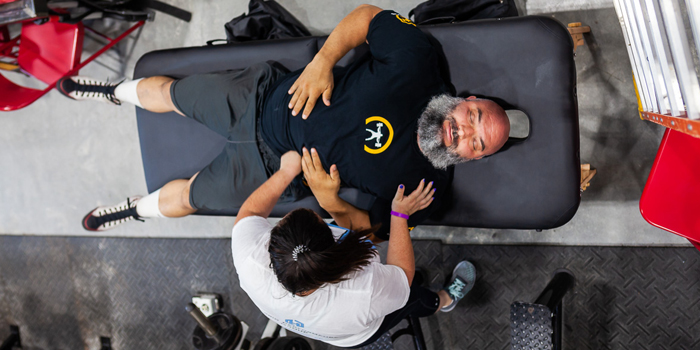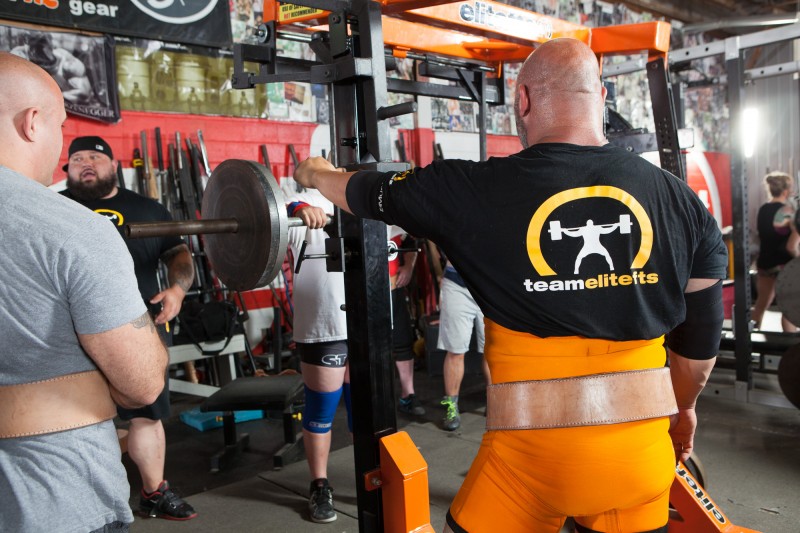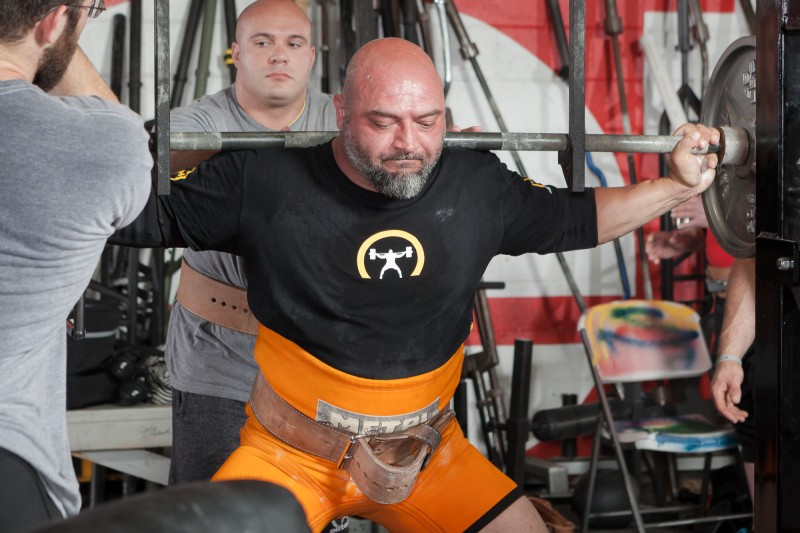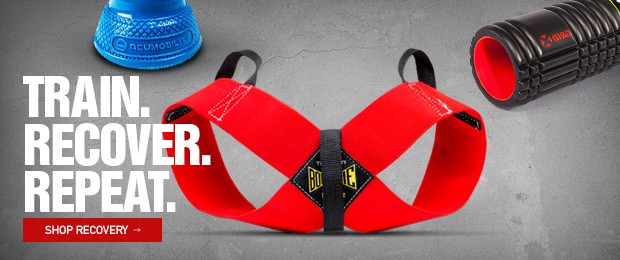
Injuries commonly occur in all sports and are one of the most difficult hurdles to overcome for an athlete. For the competitive strength athlete, access to care is usually limited either in quality or quantity, adding to the level of difficulty in dealing with an injury. Although lack of care is not exclusive to the strength athlete, it is much harder for an athlete trying to lift two to four times their bodyweight to find a quality health professional than a traditional tennis player or lifelong golfer.
Healthcare must be a relationship of relatively equal give and take. It is the job of the athlete to listen to and execute the plan of their health professional. But it is the job of the healthcare professional to earn the trust of the athlete before this relationship can be assumed. In my book, in order to qualify as being adequately suited for an athlete’s needs, the health professional must be knowledgeable in the sport in which the athlete participates or be willing to learn the demands of that sport, and is willing to work with the athlete to accomplish their goals. By that definition, we can now see why finding a good healthcare provider is so hard for strength athletes. Strength athletics are still seen by many in the healthcare industry as taboo, reckless sports, and are quickly blamed for the cause of all the athlete’s problems. The recreational runner is applauded for their toughness of being able to run a 10K, whereas the strength athlete pushing for an elite total is scorned. Don’t you know lifting is bad for you!? I digress.
RECENT: Why Big Air Is the Key to a Bigger Total
Because of this scenario above, most strength athletes either take matters into their own hands or seek advice from other lifters to rehab and troubleshooting an injury. Now, don’t assume my previous rant lets the athlete off the hook when it comes to their handling of an injury. This is as appalling as the doctor who perches up on the throne of their medical degree and tells you that squatting is bad for your knees.
The best scenario for any athlete is to have an outlet to qualified healthcare professionals and coaches who can empathize with the demands of their sport and are capable of determining not only the severity of an injury, but more importantly, the cause. Once the cause is identified, a good healthcare provider should educate their athletes to better understand their body, work with the athlete to develop a plan for treatment, and help prevent future injury occurrence.
Don’t have anyone in your area whom you can trust to do that? That is okay. Best case scenarios are rarely reality, and the reality is that too many strength athletes are either distrusting of their current pool of local healthcare providers or too hardheaded to go to one in the first place. If you must wade through the dark waters of troubleshooting an injury, this resource is here to help make sure you don’t drown.
Prelude
Before we begin the Troubleshooting Strength Injuries Series, it is very important to note that the intent of this series is to educate and provide guidelines for strength athletes to be able to gain better insight on troubleshooting an injury – not to self-diagnose. The goal of this troubleshooting process is to help the athlete develop a basic understanding of how injury occurs, identify the causative factors of an injury, and provide basic principles of how to modify activities of daily living and training to work through these injuries. This troubleshooting series will also provide better competence in distinguishing a mild injury that can be worked through from a more significant injury in which you should seek professional help. Chronic wear and tear and improper movement cause many injuries in sports and life. If these causative factors are addressed during the early manifestations of an injury, the condition can often be worked around and a significant injury can be prevented.
When this troubleshooting guide does not help your pain, this should be a sign to seek further assistance from a healthcare professional.
Redefining Injury
Well, Mr. Smith, I’ve got good news and bad news. The good news is your pain may not be coming from your training. The bad news is it’s still all your fault.
An injury is defined as physical harm or damage done to the body by internal or external forces. At a first look, this probably seems to be pretty spot on. Cool. I knew that. Let’s move on. But hold on, let’s take a second look — anything that causes damage to the body can be defined as an injury. Because of this, you have to consider that a wide range of activities that you perform every day are injuring your body. You must also consider that injury is part of life. Some injury is necessary for growth and performance. When you enter the gym to train, you are there to deliberately damage to your body. It’s the extent, the intent, and the mechanism to which damage is done to the body that determines whether you see that injury as a negative or positive. For the sake of understanding, for the rest of the article, we will assume that the use of the word “injury” refers to the traditional understanding of injury in which a significant enough amount of damage is sustained which structurally compromises a joint or tissue and causes pain, and “micro-injury” describes the smaller damage and stresses that the body incurs all the time.
In order to understand what to do about an injury, you first need to have a basic understanding of the injury process and how injuries occur. If you can entertain this concept, this makes your problem much easier to understand and work with. In fact, it can even provide more understanding than receiving a diagnosis from a healthcare professional.
At the basic level, an injury occurs when forces are placed on a tissue that, over time and frequency of loading, exceeds the tissue’s loading tolerance for damage. This means that injury can occur relative to a few different factors – the amounts of force, frequency, and time.
In regards to injury, the forces we are specifically talking about are forces that are being placed directly on the joints and soft tissues. Think of this as the overhead on your body to accomplish a task. Frequency refers to the number of times a strenuous load is placed on the body, and time refers to both how long a load is applied and how long the body is able to rest in between each load or bouts of loading. This may seem simple, but don’t gloss over this concept, as it is where most people fail to understand their injury. Being able to understand, apply, and tweak these variables can be the difference between being able to train or being sidelined with an injury.
To illustrate, let’s take an example: When doing a 100-pound leg extension, there are group of muscles, connective tissues, and joints that are required to accomplish the movement. On every rep, you create force to move the weight that is placed against your body. A small amount of force from every rep that you do is placed directly on the body, which causes wear and fatigue on the muscles, connective tissues, and joints in the body. You do a set to fatigue. If you are able to give yourself enough rest in between sets, you can probably do another set or two. After a few sets, your body is pretty smoked and it is a good idea to rest a few days before training that area again.
What would happen though if you just kept going? Set after set after set? Eventually, something would start hurting. Your quad might cramp up or your patella tendon could start aching. What happened? You met and exceeded the loading tolerance of the soft tissues involved in the movement. Although a 100-pound leg extension was not a significant enough weight to cause excessive force on your body in one rep, you did too many reps over too short an amount of time without enough recovery. It would be ludicrous to say that the rep in which this athlete started feeling pain was the cause of the injury, even though all the other reps were free of pain. The last rep was simply “the straw that broke the camel’s back,” right?
This may seem like an obvious scenario to avoid, but it’s because these variables in the example are so obviously ridiculous that no one with any common sense would do such a thing. But what if we expand this scenario out to be a bit more realistic?
You’re a powerlifter training for an upcoming event and are currently training four days a week while working a laborious job that requires you to stand all day and work with your hands. You do this for 50 hours a week, from 6:30 a.m. to 5:30 p.m., sometimes more, and then train after work at 6:30 p.m. three nights out of the workweek. On those nights, you don’t get to bed until 11 p.m. You’ve been told a few times that your deadlift set up could use some work and you’ve been adding in more back accessories to help push your lower back strength up. You are impatient with your deadlift being your weakest movement, so you really push these accessories, adding in heavy good mornings, bent over rows, and 45-degree back extensions into your deadlifting days.
During one training session, you are deadlifting and are feeling pretty good. You are supposed to work up to a heavy set of three that day. You had an idea of what you should be able to deadlift based on your previous competition max and end up hitting that weight for three easy reps. You are pretty excited so you decide to scrap the plan today and “see where you’re at” by doing a 1-rep max. You end up pulling a PR that day. Your form broke a bit but you were able to finish the lift and are pretty excited. As you move into accessories, you do notice some soreness in the lower back, but it’s not enough to keep you from finishing the training session.
The next day you are definitely feeling sore in the lower back, but the following day is better. You roll into the weekend and have a heavy squat day planned. Your body is a bit slow getting going, so you do a couple extra warm-up sets. You feel a bit better but still can’t quite seem to get as explosive of a transition out of the bottom. You move up in warm-up weight and feel your lower back taking more of the strain when you unrack the weight than usual. The next set you focus more on the set-up. It’s better but still there.
You have planned three working sets for the day. On your second rep on the second working set, you get out of position in the hole and your entire back seizes up. Fuck. Your spotters are there to help rack the weight, and you crumple to the floor in pain. What the fuck! That should have been an easy three and now you are lying on the floor, five weeks out from a meet with an injury.
Many injuries seem to come out of nowhere while training with submaximal loads or performing movements that have done without pain a thousand times. This often leaves the athlete frustrated and dumbfounded as to why they are injured. But the reality is there are plenty of warning signs and variables at play that put this athlete at risk for injury. You just need to learn how to look for and identify them. How many can you pick out? Go ahead and list them out yourself.
Being able to identify the variables (force, frequency, and time) that are compounding or furthering your risk of injury plays a huge factor in being able to adapt your life to decrease the likelihood of injury. Initially, it may not be obvious, and unfortunately, sometimes the best teacher for an athlete is experiencing an injury.
I hope that this series allows the athlete to better identify these factors without having to learn the hard way. Even so, some of you will choose to use some of the information presented in this series and neglect other information and may still end up needing a harsh reality check to apply everything in this series – and that’s OK. Making mistakes is part of life, and looking back on what was going on before an injury occurred is a very good way to avoid the next one.
The more you can learn to identify these variables, the better you will be in adapting your life and training to be able to reach your goals. Each variable presented exists in everything we do every day. They are present when you are at work, home, and in the gym. They are present in your sleep, in your commute to work, even while you are watching TV on a Sunday.
Those goals of this series are:
- Understanding the basic concepts of injury;
- Taking an honest look at the variables of force, frequency, and time;
- Understanding how those variables are currently affecting you;
- Identifying these variables as the underlying causes of injuries; and
- Tweaking these variables will allow you to work around your injury.
P.S. For those of you who counted, there were 13 different variables in the injury scenario.












